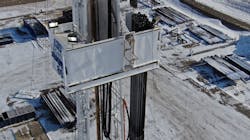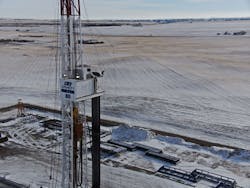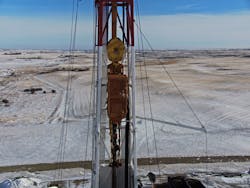A Canadian Rig Rolls On—Even in Rough Weather
Workers at AKITA Drilling had seen these conditions before. With temperatures at nearly 40 degrees below zero and winds at 60 miles per hour in Saskatchewan, workers had to shut down potash drilling operations because the company’s rig would become inoperable.
“We tried multiple ways to combat the wind messing with the service loop,’’ said Justin Amyotte, a field superintendent with AKITA. “We even went as far to set up the rig in the direction of the predominant winds. We had a worker stationed on the floor watching the service loop at all times during high winds. We shut down if it was too bad.”
This time, however, AKITA’s workers were not required to suspend operations. An eight-hour retrofit on the previous day included the installation of an energy chain that stood up to the demands of the rough Canadian winter. The energy chain serves as the service loop for the 500,000-lb capacity pad drilling triple rig and is the heart of the unit. This time, the 21.5-meter (nearly 70 ft) energy chain manufactured by igus helped the pulse remain steady throughout the cold Canadian night.
“Continuous operational time and prevention of downtime are paramount for drilling rig operations,’’ said Alan Kwoo of igus, who helped design the energy chain retrofit. “Lost production means lost revenues.”
Critical Service Loops
Whether the drilling operation is used for oil, gas, potash or any other mineral, service loops power the entire structure.
Service loops refer to the supply lines for electricity, hydraulics and pneumatics. A large electrical drilling motor installed in a derrick or mast supplies the torque to drill, which can extend down to depths as far as 10 kilometers.
Electrical service loops serve as the power source between the mast and the top drive. They provide the power to the main motor and auxiliary power for functions such as lighting and cooling fans. They also provide power to capture data and operate the rig.
Most service loops are made with steel. They require regular maintenance, as delaying any repair can result in deadly consequences in dangerous work on a rig. Steel service loops are also susceptible to corrosion and are unreliable in high winds. The AKITA rig cables prior to the retrofit were wrapped, but the wrap wrinkles and snags easily when it comes close to the rig frame. That causes rips or pulls on the cables. The package containing cables and hoses is also costly to replace.
“Sometimes the wind gusts and grabs the service loop and sends it into mast beams,’’ Amyotte said. “Hopefully, the driller sees it and stops and fixes the snag. If he does not see it, the cords get damaged. That results in even longer downtime.”
There were also safety concerns. “There was more than one occasion where the service loop became snagged on the top drive, resulting in a dangerous overhead safety incident with high voltage cabling,’’ said Darren Hrynkiw, a senior manager for K+S Potash Canada, the owner of the potash mine. “Multiple engineered safety solutions were explored, but in most cases the solution presented other maintenance or sometimes even new safety concerns.”
An Early Test
AKITA’s rig, built in 2015, is 16 ft tall and includes a 136-ft mast. K+S, which has been in operation for 125 years, takes potash crude and further processes it into potassium chloride. Its mine in Bethune, the site of the AKITA rig, is the first greenfield potash mine in Saskatchewan in more than 40 years.
The AKITA rig worked well in normal conditions, but the company considered retrofit options due to the downtime caused by snags on the service line created by the strong winds.
“The only other solution is a rigid chain/track type system,’’ Amyotte said. “These can be bent and damaged from tubulars or on a rig move. It also does not function well with ice. Once it is damaged, the rig would be down trying to fix it.”
AKITA scheduled to retrofit the rig with the igus energy chains in mid-January. The mine had been scheduled to be temporarily shut down in February before activating again in summer. The teams wanted the new energy chains in place for testing before suspending for the rest of the winter.
The retrofit required just eight hours, and it took only 24 hours for the energy chain to get its first test. A blizzard swept through the region, bringing winds that reached 88 miles per hour along with snow and freezing rain. The storm knocked out power lines, brought six inches of snow and caused numerous power outages. Wind gusts were the highest ever recorded in nearby Regina during the month of January. Temperatures fell to nearly 40 degrees below zero. This particular storm was no garden-variety blizzard.
The rig, however, with the energy chain serving as the service loop, rolled on: no stoppages, no downtime and no workers standing on the ground watching for a potential calamity.
“Even in those extreme conditions the loop functioned very well,” Hrynkiw said. “I am always pleased when an engineered solution can be found to eliminate a safety hazard, as this is far more effective than procedural safeguards. We expect little to no maintenance given its design and there are no productivity impacts with the installation of this protective system.”
E-Loop Benefits
The e-loop energy chain includes several other benefits for drilling rigs. The igus product combines the advantages of a polymer energy chain with a Dyneema rope featuring high tensile strength. The tensile forces are absorbed by the rope and passed through the mounting brackets into the support structure. The design relieves cables of any strain and ensures a defined bend radius of the cables. The modular e-loop also withstands vibrations and shocks.
“Less downtime results in more productivity, and less damage to the rig saves money,’’ Amyotte said. “There is also an important safety component. There is 600 V AC running through those power cords and up to 600 amps before the breaker trips.”
The e-loop has a bend radius of 500 mm and includes a protective cable guidance system that eliminates service loop cable snags and hang-ups. Its modular design allows easy pre- and post-installation access. The design also makes it safer for repairs. igus, which runs its North American operations out of Providence, R.I., manufactures self-lubricating, long-lasting components that are used in a wide range of applications.
The e-loop is mounted in the middle of the mast, which is a load-bearing structure used to support and position the drill string. The e-loop traverses the 136-ft mast by going 70 ft up and 70 ft down from the center point.
Dishing on Potash
While hardly a household name, potash is nonetheless one of the most widely used minerals in the world. Canada is the world’s largest producer and exporter of potash, and Regina is one of the nation’s regions with the richest potash reserves.
Potash is a group of minerals and chemicals containing potassium, which is a basic nutrient for plants and an important ingredient in fertilizer (where it supports plant growth, increases crop yield and disease resistance, and enhances water preservation). Root vegetables, such as carrots, parsnips, peas, beans and fruit, are products that grow better with potash.
The product is critical to the Canadian economy, especially in Saskatchewan. In 2017, exports of potash from Saskatchewan amounted to more than $5 billion. Potash production generated direct payments to the provincial government of more than $308 million CAD in 2017-18.
With those numbers, it is easy to understand why reducing downtime to a minimum is essential for AKITA and K+S. Potash is critical not only for the world’s food supply chain, but also to keep businesses and investors happy.
While the technology in this application was used for potash, Amyotte said any rig could use the technology. “A drilling rig is a drilling rig,’’ he said. “What it drills for doesn’t matter. It could be a huge benefit on any drilling rig.”
After years of frustration caused by weather-related downtime, Amyotte now believes he has a solution that will help keep the AKITA rig remain operational despite what Old Man Winter throws at the intrepid Canadian workers.
“We worked out a great solution,’’ Amyotte said. “This has been a challenge for us for a while, so it’s nice to have something we can depend on.”
Scott Parker is the igus product manager for energy chain systems in Canada.



